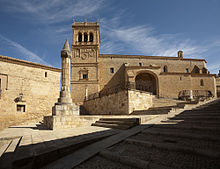Morón de Almazán
| Morón de Almazán municipality | ||
|---|---|---|
 Morón de Almazán - town center
|
||
| coat of arms | Map of Spain | |
 Help on coat of arms |
|
|
| Basic data | ||
| Autonomous Community : |
|
|
| Province : | Soria | |
| Comarca : | Comarca de Almazán | |
| Coordinates | 41 ° 25 ′ N , 2 ° 25 ′ W | |
| Height : | 1004 msnm | |
| Area : | 62.06 km² | |
| Residents : | 193 (Jan. 1, 2019) | |
| Population density : | 3.11 inhabitants / km² | |
| Postal code : | 42223 | |
| Municipality number ( INE ): | 42123 | |
| administration | ||
| Website : | www.morondealmazan.es | |
Morón de Almazán is a place and a small mountain community with only 193 inhabitants (as of January 1, 2019) in the southeast of the Spanish province of Soria in the autonomous community of Castile-León . The village of Señuela , which is five kilometers away and only has eight inhabitants, also belongs to the municipality .
location
The place Morón de Almazán is located in the mountain landscape in the southeast of the province of Soria at an altitude of about 1000 meters above sea level. d. M. The distance to the provincial capital Soria is almost 50 kilometers (driving distance) in a northerly direction.
Population development
| year | 1960 | 1970 | 1981 | 1991 | 2001 | 2012 |
| Residents | 917 | 618 | 444 | 262 | 264 | 228 |
In the first half of the 20th century the number of inhabitants was constant at around 1,100. The increasing mechanization of agriculture and the resulting loss of jobs have contributed to a large extent to the significant population decline in recent decades.
economy
For centuries the place served as an important trade, craft and service center for the rural villages and farmsteads in the area. It was also an important station in the system of trade and livestock routes ( Cabaña Real de Carreteros ) in northern Spain. Today tourism in the form of renting out holiday homes ( casas rurales ) plays a not insignificant role for the town's income.
history
After the Arab-Moorish conquest , large areas in the north of the Iberian Peninsula were depopulated . Despite the early 10th century under the Castilian Count Gonzalo Téllez and then in the second half of the 11th century under Alfonso VI. For the time being, the reconquest ( reconquista ), which culminated in the capture of the city of Toledo, some 200 kilometers further south (1085), was still in the hands of the Moors at the end of the 11th century and was only taken over by the Moors in 1128 Troops of Alfonso I recaptured. After the resettlement by Christians from the north, the place received city rights in 1304.
Attractions
While most of the houses in the town are more recent or plastered, the town center, which is under monument protection, forms an ensemble that is well worth seeing:
- The parish church ( Iglesia de San Juan Bautista ), mostly made of stone , is a single-nave building in the transitional style between late Gothic and Renaissance . The three upper floors of the tower deserve special attention with a multitude of Plateresque style elements - including two surrounding friezes with mythical animals and heraldic shields etc .; the tower closes with a surrounding balustrade , which is interrupted by corner and central pinnacles . Inside the church there is a remarkable baroque altarpiece and a Romanesque statue of the Virgin Mary.
- In the square in front of the church there is a court pillar ( rollo or picota ) with a crowning, conical top on an initially square, later round base, which is stepped back several times, with several small heraldic shields incorporated in the lower part.
- The Palacio de los Mendoza, built around 1540, is located right next to the church. Its portal with a stepped gable above shows clear style elements of the Renaissance. The two balconies on the upper floor are each framed by a rectangular alfiz . Inside is a regional costume museum ( Museo del Traje Popular Soriano ).
- Señuela
The village of Señuela , which belongs to the municipality but is just under five kilometers southwest of Morón de Almazán, impresses with its decaying rusticity. The church dates from the 16th century. The local blacksmith's shop and a bakery have been restored and can be visited on request; the cattle trough consists of several individual stone troughs.
Web links
- Morón de Almazán - Photos + Info (Spanish)
- Morón de Almazán - video
- Señuela - Video + Info (Spanish)
Individual evidence
- ↑ Cifras oficiales de población resultantes de la revisión del Padrón municipal a 1 de enero . Population statistics from the Instituto Nacional de Estadística (population update).

